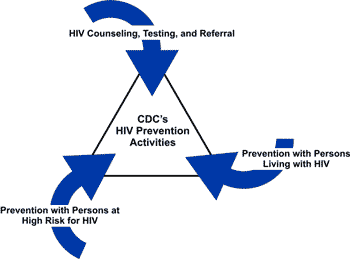|
The
Centers for Disease Control and
Prevention’s new initiative, Advancing
HIV Prevention: New Strategies for
a Changing Epidemic, is aimed at
reducing barriers to early diagnosis of HIV
infection and, if positive, increasing
access to quality medical care, treatment,
and ongoing prevention services. The
initiative emphasizes the use of proven
public health approaches to reduce the
incidence and spread of disease. As with
other sexually transmitted diseases (STDs)
or any other public health concern,
principles applied to prevent disease and
its spread will be used, including
appropriate routine screening,
identification of new cases, partner
counseling and referral services, and
increased availability of sustained
treatment and prevention services for those
infected.1
CDC’s
HIV prevention activities over the past two
decades have focused on helping uninfected
persons at high risk for HIV change and
maintain behaviors to keep them uninfected.
Despite these efforts, the number of new HIV
infections is estimated to have remained
stable and the number of persons living with
HIV continues to increase.
The
new initiative capitalizes on new rapid test
technologies, interventions that bring
persons unaware of their HIV status to HIV
testing, and behavioral interventions that
provide prevention skills to persons living
with HIV.

The
next decade promises new hope as three
primary areas of HIV prevention are
emphasized:
- Early
detection of persons who are HIV
positive and referral to care services
- Prevention
interventions with persons living with
HIV
- Prevention
with persons who are at high risk for
HIV infection
CDC,
other federal agencies, and the HIV
prevention community will continue their
work to help ensure prevention efforts in
these three areas are sustained and
reenergized as an integrated approach. This
broad scope will bring the best prevention
science to the fight against HIV/AIDS to
reduce HIV transmission.
An
emphasis on greater access to testing and on
providing prevention and care services for
persons living with HIV can reduce new
infections and lead to reductions in
HIVassociated morbidity and mortality.2,3 In
addition, simplifying prenatal and other
testing procedures can lead to more
effective use of CDC resources to help
prevent perinatal and other HIV
transmission.
The
initiative consists of four key strategies:
- Make
HIV testing a routine part of medical
care. CDC will work with
professional medical associations and
other partners to ensure that all
healthcare providers include HIV
testing, when indicated, as part of
routine medical care on the same
voluntary basis as other diagnostic and
screening tests.
- Implement
new models for diagnosing HIV infections
outside medical settings. CDC
will fund new demonstration projects
using OraQuick®, a rapid HIV test
recently approved by the U.S. Food and
Drug Administration for use in clinical
and non-clinical settings, to increase
access to early diagnosis and referral
for treatment and prevention services in
high-HIV prevalence settings, including
correctional facilities.
- Prevent
new infections by working with persons
diagnosed with HIV and their partners. CDC
in collaboration with the Health
Resources and Services Administration (HRSA),
the National Institutes of Health, and
the HIV Medical Association of the
Infectious Diseases Society of America,
has published the Recommendations for
Incorporating HIV Prevention into the
Medical Care of Persons with HIV
Infection. These groups will work to
disseminate this document to a variety
of health care providers.
- Further
decrease perinatal HIV transmission.
CDC will promote recommendations and
guidance for routine HIV testing of all
pregnant women, and, as a safety net,
for the routine screening of any infant
whose mother was not screened. CDC will
work with prevention partners, including
the American College of Obstetricians
and Gynecologists, the American Academy
of Pediatrics, the American Academy of
Family Physicians, and the American
College of Nurse-Midwives, to
disseminate the recommendations and
support their implementation.
CDC
will monitor the implementation of these new
activities through several systems,
including new performance indicators for
state and local health departments and CBOs,
monitoring HIV incidence, and expanding its
surveillance system by implementing a
national behavioral surveillance system.
References
- CDC. Advancing HIV prevention: New
strategies for a changing epidemic. MMWR
2003;52:329-332
- Janssen RS, Holtgrave DR, Valdiserri RO,
Shepherd M, Gayle HD, DeCock KM. The
serostatus approach to fighting the HIV
epidemic: Prevention strategies for infected
individuals. Am J Pub Health
2001;91:1019–1024.
- Institute of Medicine. No time to lose:
Getting more from HIV Prevention.
Washington, DC: National Academy Press,
2001.
For
more information on CDC’s New Initiative,
visit the Divisions of HIV/AIDS Web site on
Advancing HIV Prevention
www.cdc.gov/hiv/prev_prog/ahp/.
For
information on HIV/AIDS, call CDC-INFO
24 Hours/Day at 1-800-CDC-INFO
(232-4636), 1-888-232-6348 (TTY), in
English, en Español.
Call
CDC’s National Prevention Information
Network at 1-800-458-5231 for information
and materials on HIV/AIDS. |